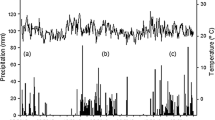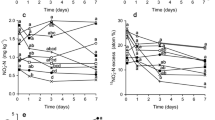Abstract
For over a hundred years shifting cultivation with slash-and-burn land preparation has been the predominant type of land use by smallholders in the Bragantina region of the Brazilian Eastern Amazon. This study contrasts the nutrient balance of slash-and-burn agriculture with a fire-free cultivation. Therefore, one half of a 3.5-year-old (28.7 t DM ha–1) and a 7-year-old woody fallow vegetation (46.5 t DM ha–1) was burnt and the other half mulched, leaving the biomass as a surface residue. Subsequently, a sequence of maize, beans and cassava was cropped for 1.5 year. Burning the 3.5- and 7-year-old fallow removed 97 and 94% of the C, 98 and 96% of the N, 90 and 63% of the P-stocks, and between 45 and 70% of the cations K, Mg and Ca of the aboveground biomass by volatilization or ash-particle transfer. These losses were avoided with the slash-and-mulch land preparation. Mulching did not increase the losses of nutrients by leaching, despite the high amount of rapidly decomposing surface mulch. Also the length of preceding fallow had no significant influence on leaching losses. At a depth of 3 m, leached nutrients were quantitatively negligible in both treatments. Comparing the nutrient fluxes at soil depths of 0.9 m, 1.8 m and 3 m, the amounts of all mobile nutrients, and also of chloride and sodium were markedly reduced during percolation and must have been retained. It is likely that nutrient retention in the subsoil layer is only temporary, emphasizing the need for a rapid re-establishment of the naturally deep-rooting secondary vegetation after abandonment of sites to enable uptake of these nutrients. The overall nutrient balance was highly negative for slash-and-burn. 291 and 403 kg N ha–1, 21 and 18 kg P ha–1, and 70 and 132 kg K ha–1 were removed from the burnt plots with a preceding fallow of 3.5 and 7 years, respectively. A reduced fallow period (3.5 years), which is a common trend in the region, resulted in a higher mean annual rate of nutrient loss averaged over the duration of the cycle than a fallow period of 7 years. Eliminating the burning losses by mulching brought the agricultural system back to an equilibrated or even slightly positive nutrient balance, even after a reduced fallow period. Thus, slash-and-mulch is a viable alternative to maintain agricultural productivity and ecosystem functioning.
Similar content being viewed by others
References
Anurugsa B. 1998. Experimentelle Untersuchungen und Modellierung bodenchemischer Reaktionen in ferallitischen Böden unter Bedingungen traditioneller Feldumlagewirtschaft. Ph.D. Thesis, University of Göttingen, Göttingen, Germany, 101 pp
Baar R. 1997. Vegetationskundliche und ökologische Untersuchungen der Buschbrache in der Feldumlagewirtschaft im östlichen Amazonasgebiet. Ph.D. Thesis. University of Göttingen, Göttingen, Germany, 202 pp.
Black A.S. and Waring S.A. 1976a. Nitrate leaching and adsorption in a krasnozem from Redland Bay, Qld. I. Leaching of banded ammonium nitrate in a horticultural rotation. Austr. J. Soil Res. 14: 171–180.
Black A.S. and Waring S.A. 1976b. Nitrate leaching and adsorption in a krasnozem from Redland Bay, Qld. II. Soil factors in-fluencing adsorption. Austr. J. Soil Res. 14: 181–188.
Black A.S. and Waring S.A. 1976c. Nitrate leaching and adsorption in a krasnozem from Redland Bay, Qld. III. Effect of nitrate concentration on adsorption and movement in soil columns. Austr. J. Soil Res. 14: 189–195.
Black A.S. and Waring S.A. 1979. Effect of nitrate leaching in Oxisol columns on 15N abundance and nitrate breakthrough curves. Commun. Soil Sci. Plant Anal. 10: 521–529.
Bünemann E. 1998. Einfluß von Mulch und mineralischem Dünger auf Zea mays und Vigna unguiculatain der Feldumlagewirtschaft Ostamazoniens. Unpublished Diploma Thesis. University of Göttingen, Göttingen, Germany, 79 pp.
Denich M. 1989. DeUntersuchungen zur Bedeutung junger Sekundärvegetation für die Nutzungssystemproduktivität im östlichen Amazonasgebiet, Brasilien. Ph.D. Thesis. University of Göttingen, Göttingen, Germany, 265 pp.
Denich M., Block A., Lücke W. and Vlek P.L.G. 1998. A bush chopper for mulch production in fallow-based agriculture and resource conservation. In: Lieberei R., Voß K. and Bianchi H. (eds), Proceedings of the Third SHIFT-Workshop Manaus, March 15-19, 1998. GKSS Forschungszentrum, Geesthacht, Germany, pp. 61–66.
Doorenbos J. and Pruitt W.O. 1977. Guidelines for predicting crop water requirements. FAO Irrigation and Drainage Paper No. 24, 144 pp.
Fearnside P.M., Leal N. and Fernandes F.M. 1993. Rainforest burning and the global carbon budget: biomass, combustion ef-ficiency, and charcoal formation in the Brazilian Amazon. J. Geophys. Res.-Atmos 98 (D9): 16733–16743.
Gehring C., Denich M., Kanashiro M. and Vlek P.L.G. 1999. Response of secondary vegetation in Eastern Amazonia to relaxed nutrient availability constraints. Biogeochemistry 45: 223–241.
Hölscher D. 1995. Wasser-und Nährstoffhaushalt eines Agrarökosystems mit Waldbrache im östlichen Amazonasgebiet. Ph.D. Thesis. University of Göttingen, Göttingen, Germany, 134 pp.
IBGE 1997. Censo agropecuário 1995-1996. No. 5, Pará, Rio de Janeiro, Brasil.
Kato M.S.A., Kato O.R., Denich M. and Vlek P.L.G. 1999. Firefree alternatives to slash-and-burn for shifting cultivation in the eastern Amazon region: the role of fertilizers. Field Crop Res. 62: 225–237.
Kauffman J.B., Sanford R.L.Jr., Cummings D.L., Salcedo I.H. and Sampaio E.V.S.B. 1993. Biomass and nutrient dynamics associated with slash fires in neotropical dry forests. Ecology 74: 140–151.
Kinjo T. and Pratt P.F. 1971a. Nitrate adsorption: I. In some acid soils of Mexico and South America. Soil Sci. Soc. Am. Proc. 35: 722–725.
Kinjo T. and Pratt P.F. 1971b. Nitrate adsorption: II. In competition with chloride sulfate and phosphate. Soil Sci. Soc. Am. Proc. 35: 725–728.
Lide D.R. 1998. CRC Handbook of Chemistry and Physics: A Ready-reference Book of Chemical and Physical Data. 79th ed. CRC, Boca Raton, FL, 2556 pp.
Mackensen J., Hölscher D., Klinge R. and Fölster H. 1996. Nutrient transfer to the atmosphere by burning of debris in eastern Amazonia. For. Ecol. Manage. 86: 121–128.
Marquardt D.W. 1963. An algorithm for least-squares estimation on non-linear parameters. SIAM J. Appl. Math. 11: 443–441.
Rego R.S., da Silva B.N.R. and Junior R.S.O. 1993. Detailed soil survey in an area in the municipality of Igarapé-Açu. In: Summaries of Lectures and Posters Presented at the 1st SHIFTWorkshop in Belém, March 8-13, 1993, pp. 146. EMBRAPACPATU, 202 pp.
Schroth G., da Silva L.F., Seixas R., Teixeira W.G., Macêdo J.L.V. and Zech W. 1999. Subsoil accumulation of mineral nitrogen under polyculture and monoculture plantations, fallow and primary forest in a ferralitic Amazonian upland soil. Agr. Ecosyst. Environ. 75: 109–120.
Snyder R.L. and Pruitt W.O. 1992. Evapotranspiration data management in California. Irrigation and Drainage Session Proceedings/ Water Forum 1992 EE, HY, IR, WR Div/ASCE Baltimore, MD, August 2-6, 1992, pp. 128–133.
Sollins P., Robertson P. and Uehara G. 1988. Nutrient mobility in variable-and permanent-charge soils. Biogeochemistry 6: 181–199.
Sommer R. 2000. Water and nutrient balance in deep soils under shifting cultivation with and without burning in the Eastern Amazon. Ph.D. Thesis. Cuvillier Verlag Göttingen, Germany, 226 pp.
Sommer R., Denich M. and Vlek P.L.G. 2000. Carbon storage and root penetration in deep soils under small-farmer land-use systems in the Eastern Amazon region, Brazil. Plant Soil 219: 231–241.
Sommer R., Fölster H., Vielhauer K., Maclouf Carvalho E.J. and Vlek P.L.G. 2003. Deep soil water dynamics and depletion by secondary vegetation in the Eastern Amazon. Soil Sci. Soc. Am. J. 67: 1672–1686.
Thielen-Klinge A. 1997. Rolle der biologischen N2-Fixierung von Baumleguminosen im östlichen Amazonasgebiet, Brasilien-Anwendung der 15N natural abundance Methode. Ph.D. Thesis, University of Göttingen, Göttingen, Germany, 202 pp. Internet Publication: http://www.sub.uni-goettingen.de/f_digbib.htm
Thurston H.D. 1997. Slash/mulch systems. Sustainable methods for tropical agriculture. Westview, London, 196 pp.
Toner C.V., Sparks D.L. and Carski T.H. 1989. Anion exchange chemistry of middle Atlantic soils: charge properties and nitrate retention kinetics. Soil Sci. Soc. Am. J. 53: 1061–1067.
Uehara G. and Gillman G. 1981. The mineralogy, chemistry, and physics of tropical soils with variable charge clays. Westview Tropical Agriculture Series, No. 4. Westview, Boulder, CO, 170 pp.
Van Genuchten M.T. 1980. A closed-form equation for predicting the hydraulic conductivity of unsaturated soils. Soil Sci. Soc. Am. J. 44: 892–898.
Viera L.S., dos Santos W.H., Falesi I.C. and Filho J.P.S.O. 1967. —Levantamento do recon-hecimento dos solos da região Bragantina, Estado do Pará. Pesquisa Agropecuária Brasileira 2: 1–63.
Vogeler I., Clothier B.E., Green S.R., Scotter D.R. and Tillman R.W. 1996. Characterizing water and solute movement by Time Domain Reflectometry and disk permeametry. Soil. Sci. Soc. Am. J. 60: 5–12.
Wong M.T.F., Hughes R. and Rowell D.L. 1990. Retarded leaching of nitrate in acid soils from the tropics: measurements of the effective anion exchange capacity. J. Soil Sci. 41: 655–663.
Author information
Authors and Affiliations
Rights and permissions
About this article
Cite this article
Sommer, R., Vlek, P.L., Deane de Abreu Sá, T. et al. Nutrient balance of shifting cultivation by burning or mulching in the Eastern Amazon – evidence for subsoil nutrient accumulation. Nutrient Cycling in Agroecosystems 68, 257–271 (2004). https://doi.org/10.1023/B:FRES.0000019470.93637.54
Issue Date:
DOI: https://doi.org/10.1023/B:FRES.0000019470.93637.54




